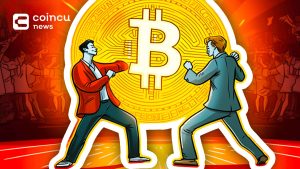Oracle is no longer new with names that have seen impressive growth in the past bull run season, such as ChainLink (LINK), Tellor (TRB), Band Protocol (BAND) … But what potential and what development is there? or not? How can Oracle reach the stage of development in the future? Which Oracle project will be the ultimate winner? Let’s find out the answer through CoinCu’s Oracle series!
In the first part we clarify together the concept of Oracle and some questions about it!
What is an oracle?
Oracle (translated in Vietnamese means “Oracle”) is understood as software or hardware that is responsible for receiving and validating data from outside into the blockchain and the smart contract, using methods such as API or market data.
If the above definition is a little confusing, just think of the following: Oracle is an intermediary that helps connect off-chain data to blockchains (on-chain)..
For example:
All types of data intended to be transmitted, received and used on computers must be encoded in binary. The data can be a text, an audio file, a video … but in general a computer needs to encode this data in binary form so that it can be received and processed.
Likewise, the blockchain and the smart contract themselves do not receive, process or authenticate any external data (data on price movements, transaction volumes …), but have to go through oracles. .
Currently, blockchain information is broken down into three main types:
- Real world data: Information from the real world.
- Crypto market data: Information about CoinMarketCap, CoinGecko such as price fluctuations, trading volumes, changes in market capitalization …
- Corporate Services: Information used for the operation of organizations and companies.
The above information is ingested by oracles for mining and use in smart contracts and blockchain. With its important functions, Oracle has helped make blockchain and smart contracts more practical.
Oracle classification
There are a few ways to classify Oracle.
– After the feed, Oracle is divided into on-chain Oracle and off-chain Oracle. The fundamental difference between the two is the source of the data. For example, the BTC / USD price from the Uniswap source is On-Chain-Oracle, the BTC / USD price from CoinGecko is Off-Chain-Oracle.
– Depending on the purpose of the project, Oracle is divided into Oracle Service Provider (Oracle service providers such as Chainlink, Band …) and Internal Oracle (which are solutions for their own projects, for example UMA has its own Oracle for their own projects. Your project).
– Through decentralization, Oracle has centralized Oracle (e.g. Oracle from Compound) and decentralized Oracle (e.g. MakerDAOs).
In this section, I’ll also explain some of the pros and cons of using on-chain and off-chain Oracle:
| On-chain oracle | Off-chain oracle | |
| advantages | – Ensuring the timeliness and continuity of the data | – Less manipulated data – Data is added to the chain by authorized persons |
| malfunction | – Easy to manipulate – Anyone can put data in the chain |
– data delayed |
Characteristics of an ideal oracle
An ideal Oracle solution should have the following characteristics:
- High accuracy: The values provided by the solution should reflect the actual value.
- Resistant to fraud and manipulation.
- Continuity and topicality: The timely provision of the data for the operation of the system should be ensured.
- Decentralized: The data provided by Oracle is validated decentrally.
The role and importance of Oracle
For blockchain in general
To illustrate the role of the oracle, I will take an example related to the Euro season event: the outcome of the game between Spain and Croatia.
Suppose a smart contract has been created to bet on the outcome of a game between Spain and Croatia. Once the outcome of the external game is confirmed, Oracle processes, confirms and submits this information to the smart contract to process the bet and transmit it to the winner. If there is no oracle, the data can be disturbed, disturbed, even changed, which leads to the reversal of the betting results.
So here’s how to see the problems Oracle solves include:
- Oracle puts information into the blockchain and thus deals with the availability of the information.
- Solve the problem of data manipulation. Oracle nodes help to collect, verify and transfer validated market data to the smart contract, resulting in the most accurate end-results that we can absolutely trust.
- Protect the transparency of information.
So what does Oracle need in DeFi? This is an important part of ensuring that everyone can rely on Oracle’s future growth potential. We’ll find out in the next few sections.
For DeFi
As a decentralized financial platform, running DeFi requires timely, continuous and accurate data. It can be said that Oracle is the driving force behind the development and stability of DeFi. In DeFi, Oracle solutions mainly provide 2 types of data: Data Feed and Data Price.
– data feed
Is an application that helps provide information for third-party services and applications.
The project provides information to third parties, which information includes:
- Weather information.
- Price information for Coinecko.
- Bitcoin block hash.
– data price
Offer prizes for other DeFi projects. DeFi projects use prices to apply to their system from which they can deliver results or execute orders such as loans, credits or cash.
end
Surely this article will give you a relative overview of Oracle. In the next few sections I will focus on analyzing the operating models of top projects such as ChainLink, Band Protocol, DIA … and the potential and challenges of Oracle in the future.
In the next article, I’ll go deeper into 3 typical Oracle projects, namely: Chainlink, Band Protocol, and Tellor. These are 3 projects that represent different token designs in Oracle. I will analyze in more detail how tokens are designed in each specific project. We’ll meet Again!
Poseidon
Check out more articles analyzing other potential DeFi projects by the Poseidon author:



















